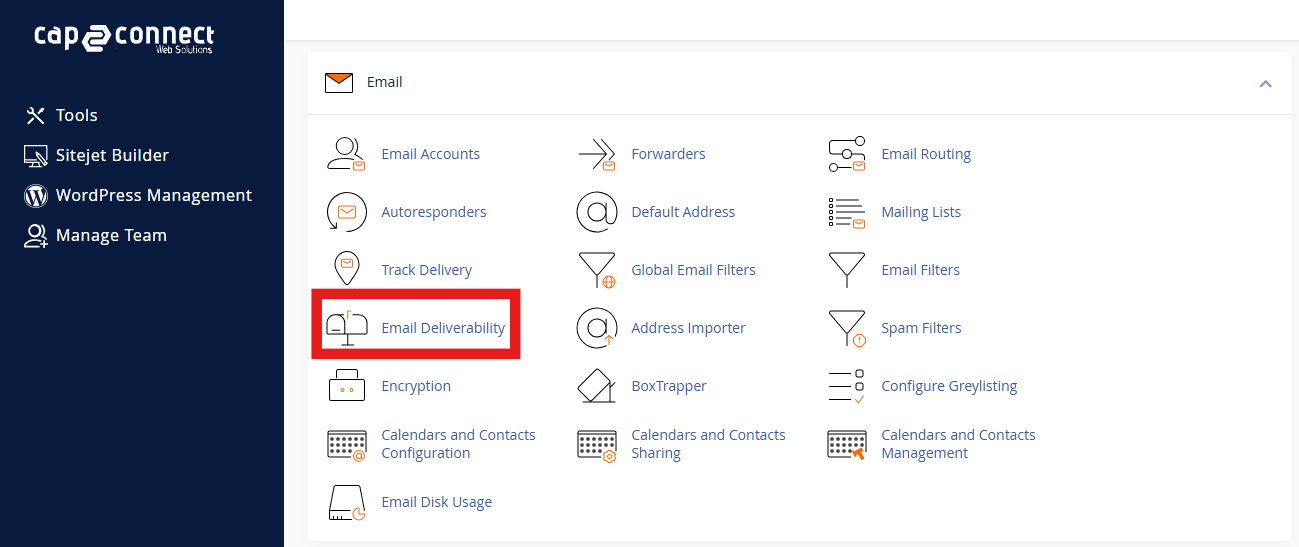Email deliverability deals with the ability of your email messages to reach recipients’ inboxes, rather than being filtered into spam or rejected by mail servers.
Several factors help ensure good deliverability: proper technical configuration, the reputation of the sender, list quality, and the relevance of your content.
This article will outline the key steps you can take to make sure that your deliverability improves and your sender reputation stays strong.
Table of Contents
1. Configure Domain Authentication
Domain authentication is the cornerstone of good email deliverability. It gives receiving mail servers a way to check whether emails coming from your domain are legitimate or not and have not been forged.
Required DNS records:
- SPF (Sender Policy Framework): This defines which servers are allowed to send emails on behalf of your domain.
- DKIM: Originally known as DomainKeys Identified Mail, it adds a cryptographic signature to your outgoing email to confirm that the message hasn’t been altered.
- DMARC: This stands for Domain-based Message Authentication, Reporting & Conformance. It tells receiving mail servers how to treat messages that have failed SPF or DKIM authentication.
These records need to be added to your domain’s DNS configuration.
After setting up, test their validity using DNS testing tools or your email service provider’s authentication tester.
You can also set up these records using the Email Deliverability functionality in cPanel. Here is a guide on how you can use it: How to use Email Deliverability feature in cPanel?

2. Build a Stable Sender Reputation
Mail providers like Gmail or Outlook consider the reputation of your domain and sending IP address.
A positive sender reputation must be acquired over time through regular, reliable sending behavior.
Best practices:
- Begin with small sending volumes and gradually increase over time.
- Avoid large-scale sends from new domains or IP addresses.
- Send only to the engaged and active contacts initially.
- Send at a consistent cadence and avoid periods of inactivity.
A stable, predictable send pattern helps build credibility and will ensure better inbox placement.
3. Maintain a Healthy Contact List
A clean, active contact list is crucial to high deliverability. Outdated or invalid addresses will cause bounces and could harm your domain reputation.
Best practices:
- Double opt-in via an authentication email for new subscriptions.
- Never buy e-mail lists. Purchased contacts often contain invalid or unconsented addresses.
- Regularly remove:
- Addresses that generate hard bounces (permanent errors);
- Contacts who have not engaged for several months;
- Unsubscribed users or those who reported your emails as spam.
- Segment your audience by engagement levels and send more or less frequently to each.
- Keep a suppression list of all invalid, bounced, or unsubscribed addresses and suppress those in all future sends.
Proper list hygiene can improve deliverability by reducing bounces and spam complaints.
4. Craft Compliant and Relevant Email Content
Design and content directly impact how spam filters will view your emails. Make sure each message adheres to accepted best practices.
Recommendations:
- Write clear, accurate subject lines that reflect the content of your message. Do not use all caps, overuse punctuation, or spam-trigger words, like “Free,” “Act now,” or “Win.”
- Use an appropriate ratio of text to image. Emails with too much imagery are more likely to be filtered.
- Use only reliable and verified links. Avoid broken links or shortened URLs.
- Always include a visible unsubscribe link that works correctly.
- Use a recognizable “From” name and email address, like “Support Team” or “YourCompany support@yourdomain.com”.
- Wherever possible, make your content personalized to create more involvement-open and click rates.
It means quality and relevance equate to a signal of legitimacy to mail providers and better engagement metrics, both key components of better deliverability.
5. Monitor Performance and Sender Reputation
You can only catch and fix deliverability issues early by monitoring performance metrics.
Key metrics to track:
- Open rate: This tells you how engaging your sender name and subject line are.
- Click-through rate (CTR): This measures engagement with your content.
- Bounce rate: Should remain below 2%.
- Spam complaint rate: No more than 0.1%
- Unsubscribe rate: High rates could hint at irrelevant content or too much frequency.
Recommended tools:
- Google Postmaster Tools: Check your domain reputation and delivery errors.
- Sender Score or Microsoft SNDS : Assess IP reputation.
- Blacklist checkers: Check whether the domain or IP is on major blocklists or not.
If you’re not seeing performance metrics improve, pause large sends, take some time to review your list quality, and consider adjusting your sending practices.
6. Control Sending Frequency and Volume
Large or irregular sending volumes may trigger spam filters and hurt your reputation. Mail providers favor senders who send consistently in controlled volumes.
Best practices:
- Gradually increase sending volume over time.
- Avoid sending mass campaigns to inactive or unengaged contacts.
- Make sure you stay within your account limits and do not mass email people.
- If you intend on running an email campaign, consider a dedicated service, as they are designed to handle high volumes of email while offering more advanced tools, features, and analytics.
- Send your emails in batches rather than sending them all at once.
Conclusion: Improvement in email deliverability requires a mix of technical accuracy with consistent sending practices and relevance of content. Authenticate your domain, keep your contact list clean, generate compliant content, and monitor performance regularly for a strong sender reputation that will make sure your messages reach your recipients’ inboxes.